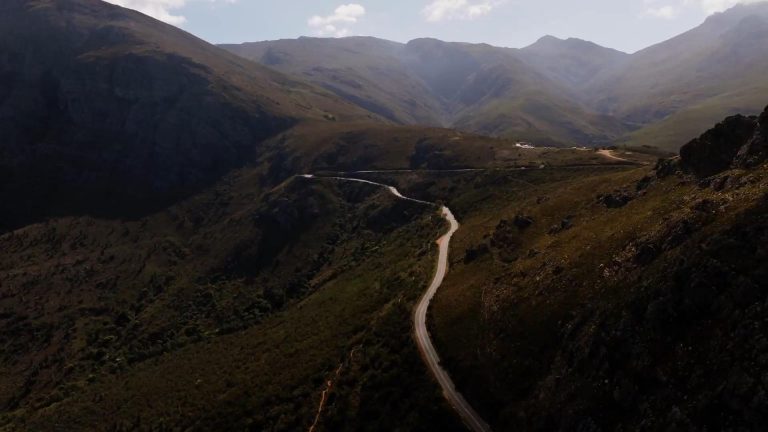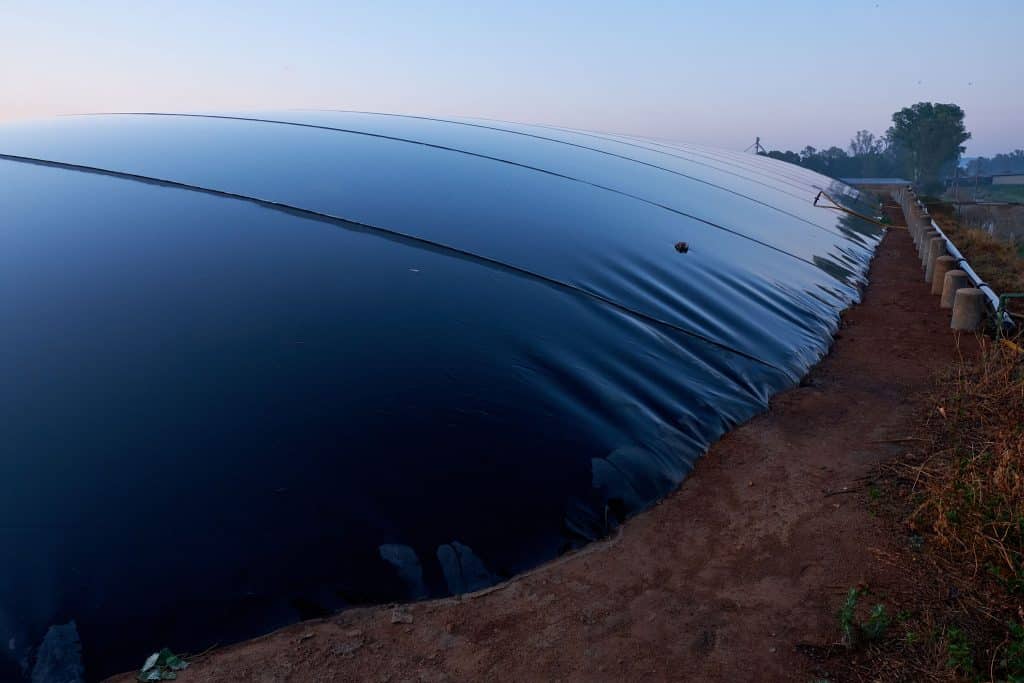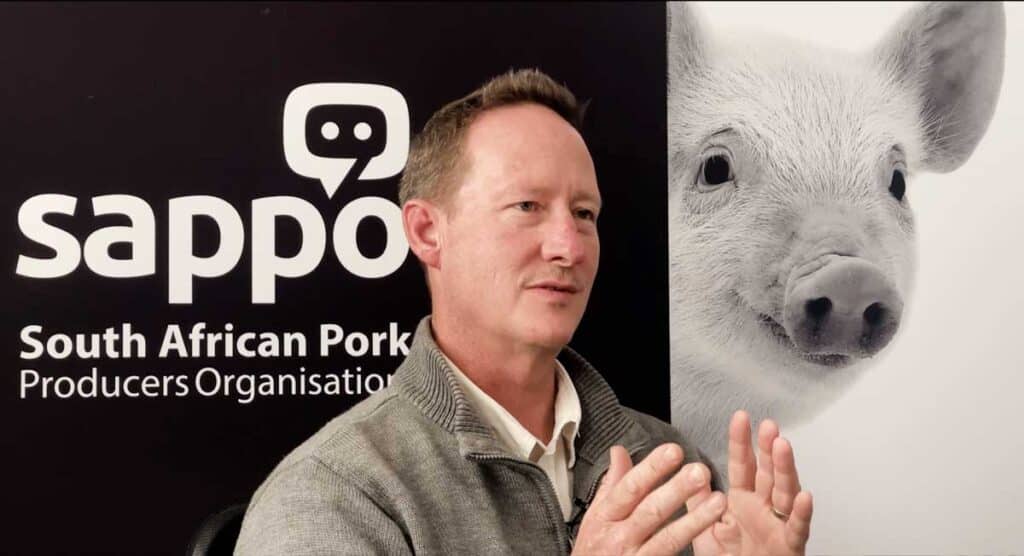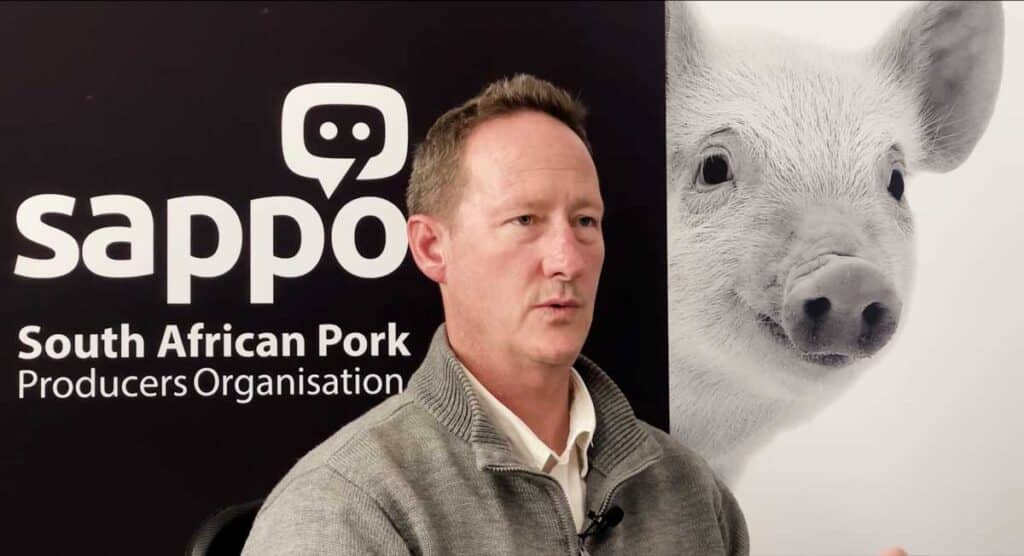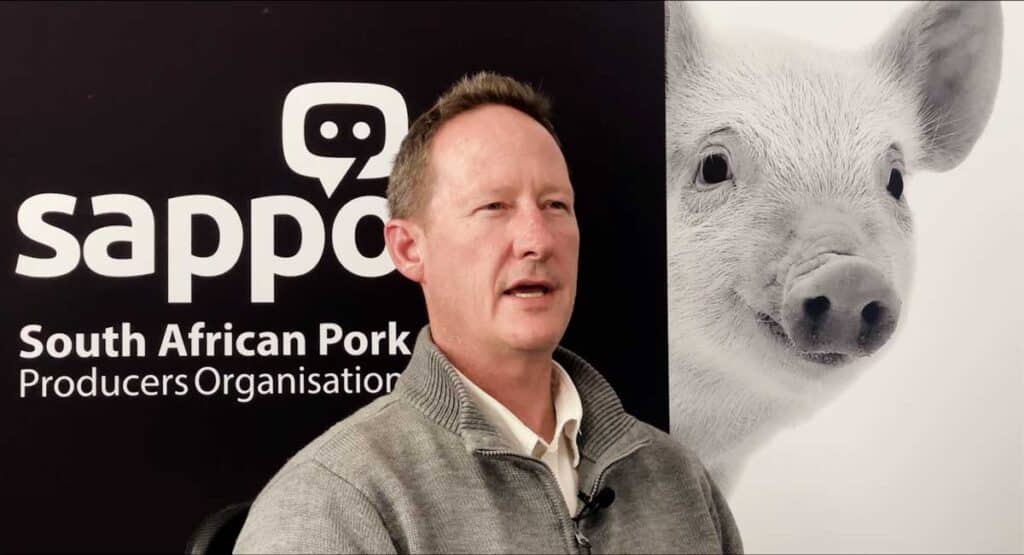SAPPO recently interviewed biogas expert, Jason Gifford, director at Logical Waste, to help pig farmers better understand the feasibility of biogas as an alternative energy source. In this easy-to-understand, 13-part mini-series, he answers some of your most pressing questions from cost implications and economic viability to South Africa’s policies and incentives, as well as successful South African case studies.
Episode 1: What is biogas, and how is it produced in South Africa?
In the first episode, Jason Gifford explains that biogas is a renewable energy source created when organic matter, such as food waste and manure, is broken down by microorganisms (bacteria) in the absence of oxygen. This process releases biogas, consisting primarily of methane and carbon dioxide, alongside other by-products, which are captured in a biogas dam. Before it can be used as an energy source that may be used to produce electricity, the contaminants, namely hydrogen sulphide and water, need to be removed. Essentially, any biological product could produce biogas, but it needs to be cost-effective and have biomass that degrades readily.
Episode 2: Is pig manure an effective feedstock in terms of energy conversion and can multiple feedstocks be used in one biogas plant?
On a piggery, manure is an effective feedstock for anerobic digestion as it is produced all the time and is easy to manage because it is produced in a relatively small area and has the infrastructure to capture, manage, and move it via a lagoon. Our climate doesn’t require the lagoons to be heated, it simply means that the anaerobic process might require more time.
As pigs are fed a combination of plant matter and minerals, their manure is already a multi-feedstock. In the right situation, you could add other feedstocks to your manure, such as maize that has gone sour, cow manure, and food waste from other production processes. Incorporating other feedstocks into your lagoon is only limited by your economic radius of transportation and biosecurity due to biohazards, but you could have a lagoon in between farms and other that is located outside of their zoned areas.
Biogas production is a biological system that is not switched on and off. It requires managing the bacteria’s environment for constant gas production. If you want to introduce something new to the system it needs to be done slowly so that the bacteria may acclimatise, and the same goes for withdrawing a component.
Episode 3: What are some of the challenges and barriers to the widespread adoption of biogas in South African pig farming and how can they be addressed?
In this episode, Jason identifies two of the main challenges to the widespread adoption of biogas production in South Africa’s pig farming industry, namely the high cost of projects and the negative perceptions surrounding past failed projects. However, it should be noted that many successful commercial biogas projects across the country – including those using pig manure from single or multiple feedstocks – are not as widely publicised as the failed projects, creating a distorted perception of the viability of biogas projects. Promoting such viable projects will build confidence in the technology’s potential and increase investment opportunities in future projects.
Episode 4: What are the current policies and incentives in place to encourage biogas production and use?
At the moment there are no stand-alone incentives for biogas production, particularly in the South African agricultural sector, Jason explains in this episode. However, the adoption of the norms and standards for organic waste has been a huge step in the right direction. It has removed the requirement for environmental authorisations for compliant biogas projects. The next big thing needed to unlock the potential of the sector is the simple mechanism to sell power. This would remove the biggest barriers to the sector – namely what to do with the excess power that is generated. The landscape is changing, however, and with this comes the realisation that not all projects have to be hundreds of megawatts in order to make sense. Even small-scale projects can plug into existing infrastructure and push power back into the grid. Legislation is already in place to allow for this, it’s just a matter of the final pieces falling into place.
Episode 5: What role can biogas play in transitioning to a more sustainable energy system?
The production of biogas has a significant role to play in South Africa’s agricultural sector as it can be used to treat organic waste, stabilise it by removing the volatile elements, and produce an end-product that is beneficial for the environment. It will reduce our dependence on chemical-based fertilisers – of which there has been a shortage post pandemic and with the Russia‒Ukraine conflict – and will also provide a solution for the reduced use of greenhouse gases in energy production. Harnessing biogas is a possible solution to the energy crisis that may address multiple other environmental issues at the same time.
Episode 6: What are some examples of successful biogas projects, and what lessons can be learned from them?
Anaerobic digestion is nothing new in South Africa; it has been around for many years, it has just flown under the radar as an energy solution until now. Numerous South African listed companies have been using the process to address their energy requirements, generate power, and recover water to be reuse in their processes once again. Anaerobic digestion has been used to stabilise organic matter by removing nutrients during municipal waste water treatment, for example. South Africa’s first anaerobic digestion plant, established by Johannesburg Water, was used to generate 1,1 MW, while the Bronkhorstspruit Biogas Project was the first commercial, independently owned project in the country.
Episode 7: How does the cost of biogas production compare to other renewable energy sources, such as solar or wind?
In comparing biogas production to other renewable energy sources, it is important to consider the availability of energy delivered to the grid. While wind and solar have varying availabilities depending on weather conditions, biogas production is consistent since the biological process never ‘sleeps’, so to speak. Biogas plants can be used as a baseload power supply, running 24/7, whereas solar and wind require expensive batteries for energy storage to provide energy when the renewable sources are not available. When comparing the cost of energy that is delivered 24/7, biogas plants are substantially less expensive than wind or solar farms. While the initial capital investment for biogas production is substantial, the long-term operating cost may be lower when compared to other renewable energy supplies.
Episode 8: What are the factors that determine the economic viability of a biogas project?
The economic viability of a biogas project depends on various factors that are specific to the project, such as its size, who operates and manages it, and the economic radius to remove the nutrient. Farmers are beginning to recognise that the nutrient value of digestate has great economic potential, especially as farms start to recognise the benefits of using and selling organic substrates for soil management.
A 50 kW plant may be commercially viable in certain situations like for smaller farms, but might have to start at 150 kW for certain larger farms. The economic viability of a biogas project is not a one-size-fits-all solution, and each project needs to evaluate its requirements.
Episode 9: What are the key risks and uncertainties involved in investing in a biogas project, and how can they be managed?
Investing in a biogas project is a journey that requires the farmer’s involvement in the process; the greater the farm’s involvement, the greater the potential benefits down the road. Meanwhile, the key risks and uncertainties involved in investing in a biogas project include estimates about gas production, costs, and various other unknowns like geotechnical reports. Mitigating these risks requires doing the necessary homework to understand how the plant works and asking many questions – before and during the process – and finding the right company to work with. It’s essential to find a suitably qualified and locally-based company with experience that can provide local support in terms of set up, maintenance and support, rather than being too dependent on international suppliers and partners.
Episode 10: What is the potential for biogas projects to create jobs and contribute to local economic development?
Biogas projects have a high potential to create employment opportunities and to contribute to local skills development, both during the construction phase as well as the operation maintenance phase. Biogas projects that provide an organic replacement to chemical fertilisers can also contribute to job preservation by supporting the farm’s food production programme. In the long run, projects that allow a farm to continue its operations can save jobs and prevent farms from closing.
Episode 11: What are some successful examples of biogas projects that have demonstrated economic viability, and what lessons can be learned from them?
There are more than 30 large, commercial-scale biogas projects across South Africa and within various sectors from the petrochemical industry to industrial food processing and primary food production. There is certainly an economic case for biogas projects on farms with sufficient volumes of manure, and we have seen this at dairy farms and chicken abattoirs. One of our most successful and economically viable biogas projects in the agricultural space includes Riverside Piggeries, near Pretoria.
Episode 12: How do you see the economic viability of biogas projects evolving in the future?
Biogas projects are becoming increasingly important, especially in a South African context, due to their ability to provide 24/7 power on-demand to run farms. Their economic viability will continue to evolve and will become even more crucial going forward. A robust energy solution will consist of a hybrid model that combines a number of technologies and alternative energy supplies. Despite the decreasing cost of establishing wind and solar farms, biogas technology still holds a relevant place in this mix due to its ability to provide power around the clock, as well as its ability to prevent noxious odours and help eliminate vermin and other pests such as flies on-farm.
Episode 13: How can a South African producer assess his readiness to explore biogas viably?
A South African farmer may assess their readiness to explore biogas by partnering with an experienced company that understands the space and their specific requirements. The farmers should start by asking themselves what they would deem as being viable in their context and what their project would need to address. To begin with, investing in a lined, covered, mixed lagoon is a reliable way for farmers to understand whether they are producing enough gas volume, which may be measured by using a gas-flow meter. The farmers should also be able to destroy the gas in a responsible way, by burning it and converting the methane to carbon dioxide and water.
If you’re still looking for more reasons to turn to a more reliable, alternative energy source to keep your farm running while being more eco-friendly, watch our SAPPO Selekt short film about how SAPPO farmer Michael Fysh, managing director of the family-owned Riverside Piggeries, made the switch.

Jason Gifford has spent the past two decades developing biogas-to-energy solutions and technology for processing organic waste streams. He currently heads up two companies in this industry, Logical Waste and Logical Water, and is a previous chairperson of the Southern African Biogas Industry Association (SABIA). Driven by process solutions suited to our environment, these companies design and build equipment for the handling and utilisation of organic waste streams and represent international partners in the organic waste utilisation, water and wastewater treatment sectors.
Some of Jason’s biogas highlights include South Africa’s only biogas-to-energy installation on a municipal wastewater treatment plant and the recent biogas combined heat and power plant at Riverside Piggeries.
The South African Pork Producers’ Organisation (SAPPO) coordinates industry interventions and collaboratively manages risks in the value chain to enable the sustainability and profitability of pork producers in South Africa.






